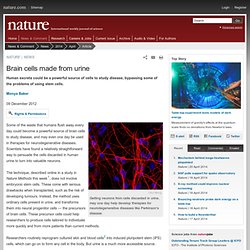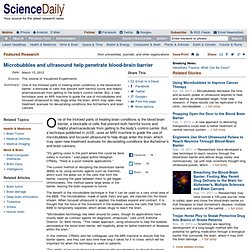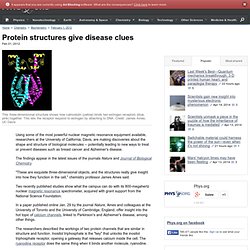

Brain cells made from urine. Lihui Wang Getting neurons from cells discarded in urine, may one day help develop therapies for neurodegenerative diseases like Parkinson's disease.

Some of the waste that humans flush away every day could become a powerful source of brain cells to study disease, and may even one day be used in therapies for neurodegenerative diseases. Scientists have found a relatively straightforward way to persuade the cells discarded in human urine to turn into valuable neurons. The technique, described online in a study in Nature Methods this week1, does not involve embryonic stem cells.
These come with serious drawbacks when transplanted, such as the risk of developing tumours. Researchers routinely reprogram cultured skin and blood cells2 into induced pluripotent stem (iPS) cells, which can go on to form any cell in the body. However, in that study the team used retroviruses to insert pluripotency genes into cells — a common technique in cell reprogramming. Study Results: Adult Stem Cells From Bone Marrow. FOR IMMEDIATE RELEASE: July 3, 2012 Scientists Looking for Potential Avenue to Grow Cells of Different Organs Newswise — Baltimore, MD – July 3, 2012.

Researchers from the University of Maryland School of Maryland report promising results from using adult stem cells from bone marrow in mice to help create tissue cells of other organs, such as the heart, brain and pancreas - a scientific step they hope may lead to potential new ways to replace cells lost in diseases such as diabetes, Parkinson’s or Alzheimer’s. The research in collaboration with the University of Paris Descartes is published online in the June 29, 2012 edition of Comptes Rendus Biologies, a publication of the French Academy of Sciences. “Finding stem cells capable of restoring function to different damaged organs would be the Holy Grail of tissue engineering,” says lead author David Trisler, PhD, assistant professor of neurology at the University of Maryland School of Medicine. Link to article: Comment/Share. Microbubbles and ultrasound help penetrate blood-brain barrier. One of the trickiest parts of treating brain conditions is the blood brain barrier, a blockade of cells that prevent both harmful toxins and helpful pharmaceuticals from getting to the body's control center.

But, a technique published in JoVE, uses an MRI machine to guide the use of microbubbles and focused ultrasound to help drugs enter the brain, which may open new treatment avenues for devastating conditions like Alzheimer's and brain cancers. "It's getting close to the point where this could be done safely in humans," said paper-author Meaghan O'Reilly, "there is a push towards applications. " Protein structures give disease clues. Using some of the most powerful nuclear magnetic resonance equipment available, researchers at the University of California, Davis, are making discoveries about the shape and structure of biological molecules -- potentially leading to new ways to treat or prevent diseases such as breast cancer and Alzheimer's disease.

The findings appear in the latest issues of the journals Nature and Journal of Biological Chemistry "These are exquisite three-dimensional objects, and the structures really give insight into how they function in the cell," chemistry professor James Ames said. Two recently published studies show what the campus can do with its 800-megahertz nuclear magnetic resonance spectrometer, acquired with grant support from the National Science Foundation. The researchers described the workings of two protein channels that are similar in structure and function. "They are basically superimposable," Ames said. Explore further: How a Silly Putty ingredient could advance stem cell therapies. In the Brain, "ORMOSIL" Nanoparticles Hold Promise as a Potential Vehicle for Drug Delivery. BUFFALO, N.Y. -- In the images of fruit flies, clusters of neurons are all lit up, forming a brightly glowing network of highways within the brain.

It's exactly what University at Buffalo researcher Shermali Gunawardena was hoping to see: It meant that ORMOSIL, a novel class of nanoparticles, had successfully penetrated the insects' brains. And even after long-term exposure, the cells and the flies themselves remained unharmed. The particles, which are tagged with fluorescent proteins, hold promise as a potential vehicle for drug delivery. Each particle is a vessel, containing cavities that scientists could potentially fill with helpful chemical compounds or gene therapies to send to different parts of the human body. Gunawardena is particularly interested in using ORMOSIL -- organically modified silica -- to target problems within neurons that may be related to neurodegenerative disorders including Alzheimer's disease.
The research appeared in the journal PLoS ONE on Jan. 3.